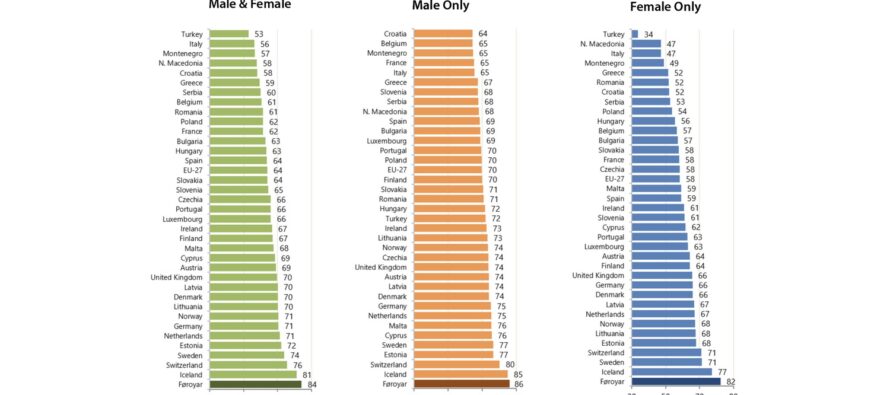Faroe Islands: Faroese labor force remains Europe’s most active

NordenBladet – With more than 84 percent of the nation’s working-age population part of the labor force, the population of the Faroe Islands still has the highest activity rate in Europe. According to a recent labor force survey published by Statistics Faroe Islands, the activity rate in the island nation is measured at 84.3 percent averaged over both sexes, or 86.1 pc. for men and 82.4 pc. for women.
The international measurement of the labor force in percentage of the working-age population counts the section of the population aged between 15 and 74 who are capable of participating in work, Statistics Faroe Islands noted.
“This is the highest activity rate in Europe, and this applies to men, women, young and old alike,” the government agency said in a statement.
The Faroese labor force has increased by just over 2,000 people in the past five years, spread evenly across the two genders, with the labor force also slightly increasing in 2020.
These are some of the key findings of the labour force survey conducted by Statistics Faroe Islands in November 2020. A detailed report with analysed figures can be found in the Statbank, the online statistical resource provided by the agency.
According the survey, the Vágar region has the highest activity rate for men, at 89 percent, and Sandoy the lowest, at 75 pc. For women, the Suðurstreymur and Norðstreymur regions have the highest activity rate, at 84 pc., and Sandoy the lowest, at 78 pc.
“In comparison, the average activity rate in Denmark and the United Kingdom is approximately 70 percent,” Statics Faroes said.
“As previous labor force surveys have also shown, the Faroe Islands are again confirmed to have the biggest labor force in Europe relative to the population. Only Iceland comes close in this respect.”
Included in the labor force are all employed individuals, including employees, independent traders, employers, unemployed people available for work and individuals who carry out unpaid work for family businesses. Not included in the labor force are young full-time students, people unavailable for work due to disease or reduced ability and people who have left the labor market due to age or other limitations. In statistical terms, these groups are classified as being part of the inactive population.
The chart below, compiled by Eurostat, compares the Faroe Islands with 35 other European nations.
With an 84-percent activity rate averaged over both sexes, the Faroe Islands are in the lead, followed by Iceland, at 81 pc., Switzerland at 76 pc., and Sweden at 74 pc.
Whereas the average activity rate for the 27 EU member nations (excluding the UK) is 64 pc., the European nations with the lowest activity rate are Turkey and Italy, at 53 pc. and 56 pc. respectively.
For men, the Faroe Islands lead the way with an activity rate of 86 pc., followed by Iceland at 85 pc. In Denmark, the corresponding figure is 74 pc. The EU average is 70 pc., with the lowest activity rate for men in Croatia, Belgium, France and Italy, all within the 64-66 pc. range.
At 82 pc., Faroese women have by far the highest activity rate in Europe, with Iceland taking second place at 77 pc. Denmark’s activity rate for women is at 66 pc., compared with an EU average of 58 pc. Turkish women have the lowest activity rate at 34 pc., followed by Italy’s 47 pc.
In all countries except for the Faroe Islands, the activity rates for women are significantly lower compared to men. In the Faroe Islands, the difference is only 4 pc. In Iceland and Denmark, it’s 8 pc., and the average difference in the EU is 12 pc. By far the greatest activity rate difference between the two sexes is in Turkey, with 72 pc. for men and 34 pc. for women.
 High quality & nature friendly luxury cosmetics from Scandinavia - ElishevaShoshana.com
High quality & nature friendly luxury cosmetics from Scandinavia - ElishevaShoshana.com

